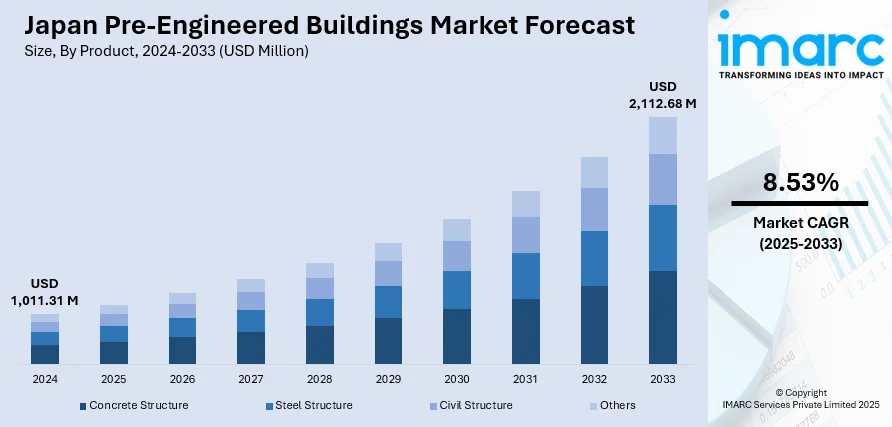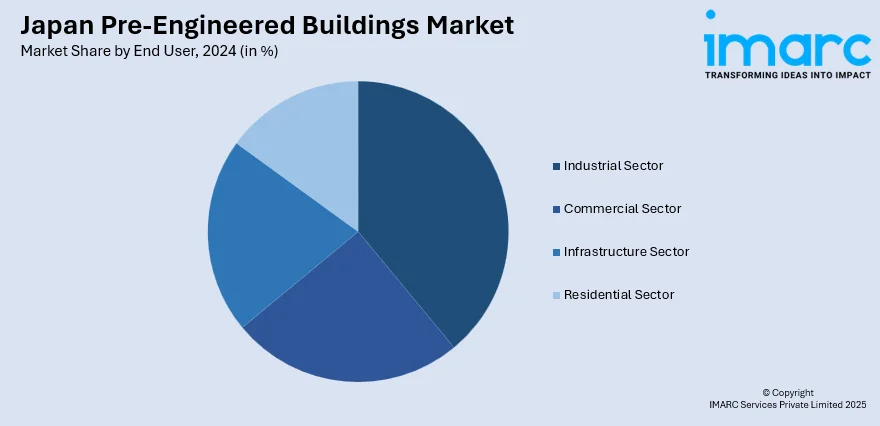
Japan Pre-Engineered Buildings Market Size, Share, Trends and Forecast by Product, End User, and Region, 2025-2033
Japan Pre-Engineered Buildings Market Overview:
The Japan pre-engineered buildings market size reached USD 1,011.31 Million in 2024. Looking forward, IMARC Group expects the market to reach USD 2,112.68 Million by 2033, exhibiting a growth rate (CAGR) of 8.53% during 2025-2033. The market in Japan is driven by rising infrastructure development, shift towards modular construction, and labor shortages. Investments in upgrading infrastructure and the growing demand for efficient, scalable solutions boost the adoption of pre-engineered buildings. These structures offer rapid construction, cost-effectiveness, and design flexibility. The Japan pre-engineered buildings market share is expected to increase steadily as demand for faster, more sustainable construction solutions continues to rise across various sectors.
|
Report Attribute
|
Key Statistics
|
|---|---|
|
Base Year
|
2024
|
|
Forecast Years
|
2025-2033
|
|
Historical Years
|
2019-2024
|
| Market Size in 2024 | USD 1,011.31 Million |
| Market Forecast in 2033 | USD 2,112.68 Million |
| Market Growth Rate 2025-2033 | 8.53% |
Japan Pre-Engineered Buildings Market Trends:
Rise in Infrastructure Development
The increasing investments in infrastructure enhancement and the necessity to upgrade outdated buildings is impelling the market growth. State-supported efforts to enhance transportation networks, medical centers, and public buildings are driving the need for affordable and expandable construction options. Pre-engineered buildings, known for their adaptable designs, rapid construction schedules, and lower labor expenses, are increasingly favored for major infrastructure endeavors. This trend is apparent in collaborations, such as the 2025 joint venture between Accenture and Infroneer Holdings, which introduced Infroneer Strategy & Innovation to update Japan's old infrastructure through digital technologies. These projects highlight the growing role of pre-engineered buildings in supporting rapid, cost-efficient modernization, prompting both public and private sectors to adopt them for projects that require timely delivery and minimal disruption.

Shift Towards Modular Construction
The rising inclination towards modular building in urban developments is bolstering the Japan pre-engineered buildings market growth. As urban areas grow denser and land becomes limited, the need for structures that can be built off-site and swiftly put together on-site is increasing. Modular construction, an essential segment of pre-engineered buildings, accelerates urban growth by allowing quicker building with little disturbance. This technique enables developers to optimize scarce urban space while adhering to strict project timelines, making pre-engineered buildings a suitable choice for infrastructure initiatives, including residential complexes, office spaces, and public amenities. The Japanese modular construction sector emphasizes this trend, achieving a valuation of USD 17.10 billion in 2024, with projections indicating it will expand to USD 27.70 billion by 2033. This expansion indicates a compound annual growth rate (CAGR) of 5.89% between 2025 and 2033, showcasing the rising need for modular, efficient construction options.
Labor Shortages and Workforce Efficiency
Japan's persistent labor shortages, particularly in the construction industry, are encouraging the adoption of pre-engineered buildings. As the population ages and the number of younger workers joining the construction sector declines, the demand for more efficient construction techniques is rising. As per government data from 2024, the senior demographic in Japan has reached a record 36.25 million, representing 29.3% of the overall population. This demographic change is leading to a declining workforce, putting strain on the construction sector. Pre-engineered structures tackle this issue by decreasing labor-heavy activities and lowering the requirement for skilled workers on location. Employing prefabricated elements facilitates quicker assembly with a reduced, less specialized labor force, easing the pressure from labor shortages and allowing for on-time project completion with improved efficiency.
Japan Pre-Engineered Buildings Market Segmentation:
IMARC Group provides an analysis of the key trends in each segment of the market, along with forecasts at the country and regional levels for 2025-2033. Our report has categorized the market based on product and end user.
Product Insights:
- Concrete Structure
- Steel Structure
- Civil Structure
- Others
The report has provided a detailed breakup and analysis of the market based on the product. This includes concrete structure, steel structure, civil structure, and others.
End User Insights:

- Industrial Sector
- Commercial Sector
- Infrastructure Sector
- Residential Sector
A detailed breakup and analysis of the market based on the end user have also been provided in the report. This includes industrial sector, commercial sector, infrastructure sector, and residential sector.
Regional Insights:
- Kanto Region
- Kansai/Kinki Region
- Central/ Chubu Region
- Kyushu-Okinawa Region
- Tohoku Region
- Chugoku Region
- Hokkaido Region
- Shikoku Region
The report has also provided a comprehensive analysis of all the major regional markets, which include Kanto Region, Kansai/Kinki Region, Central/ Chubu Region, Kyushu-Okinawa Region, Tohoku Region, Chugoku Region, Hokkaido Region, and Shikoku Region.
Competitive Landscape:
The market research report has also provided a comprehensive analysis of the competitive landscape. Competitive analysis such as market structure, key player positioning, top winning strategies, competitive dashboard, and company evaluation quadrant has been covered in the report. Also, detailed profiles of all major companies have been provided.
Japan Pre-Engineered Buildings Market Report Coverage:
| Report Features | Details |
|---|---|
| Base Year of the Analysis | 2024 |
| Historical Period | 2019-2024 |
| Forecast Period | 2025-2033 |
| Units | Million USD |
| Scope of the Report |
Exploration of Historical Trends and Market Outlook, Industry Catalysts and Challenges, Segment-Wise Historical and Future Market Assessment:
|
| Products Covered | Concrete Structure, Steel Structure, Civil Structure, Others |
| End Users Covered | Industrial Sector, Commercial Sector, Infrastructure Sector, Residential Sector |
| Regions Covered | Kanto Region, Kansai/Kinki Region, Central/ Chubu Region, Kyushu-Okinawa Region, Tohoku Region, Chugoku Region, Hokkaido Region, Shikoku Region |
| Customization Scope | 10% Free Customization |
| Post-Sale Analyst Support | 10-12 Weeks |
| Delivery Format | PDF and Excel through Email (We can also provide the editable version of the report in PPT/Word format on special request) |
Key Questions Answered in This Report:
- How has the Japan pre-engineered buildings market performed so far and how will it perform in the coming years?
- What is the breakup of the Japan pre-engineered buildings market on the basis of product?
- What is the breakup of the Japan pre-engineered buildings market on the basis of end user?
- What is the breakup of the Japan pre-engineered buildings market on the basis of region?
- What are the various stages in the value chain of the Japan pre-engineered buildings market?
- What are the key driving factors and challenges in the Japan pre-engineered buildings?
- What is the structure of the Japan pre-engineered buildings market and who are the key players?
- What is the degree of competition in the Japan pre-engineered buildings market?
Key Benefits for Stakeholders:
- IMARC’s industry report offers a comprehensive quantitative analysis of various market segments, historical and current market trends, market forecasts, and dynamics of the Japan pre-engineered buildings market from 2019-2033.
- The research report provides the latest information on the market drivers, challenges, and opportunities in the Japan pre-engineered buildings market.
- Porter's five forces analysis assist stakeholders in assessing the impact of new entrants, competitive rivalry, supplier power, buyer power, and the threat of substitution. It helps stakeholders to analyze the level of competition within the Japan pre-engineered buildings industry and its attractiveness.
- Competitive landscape allows stakeholders to understand their competitive environment and provides an insight into the current positions of key players in the market.
Need more help?
- Speak to our experienced analysts for insights on the current market scenarios.
- Include additional segments and countries to customize the report as per your requirement.
- Gain an unparalleled competitive advantage in your domain by understanding how to utilize the report and positively impacting your operations and revenue.
- For further assistance, please connect with our analysts.
 Request Customization
Request Customization
 Speak to an Analyst
Speak to an Analyst
 Request Brochure
Request Brochure
 Inquire Before Buying
Inquire Before Buying




.webp)




.webp)












